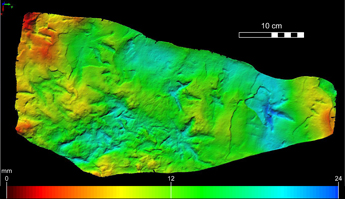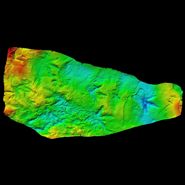Posted 05 November 2010
History of bird life on earth slashed by 25 million years
New techniques help scientists correctly identify ancient footprints
A famous set of ancient fossil ‘footprints’ discovered in the Moroccan High Atlas Mountains in the 1980s, and interpreted by some scientists as one of the earliest evidences of bird life, have been shown to belong to non-avian dinosaurs, not ancient birds.
As a result of the findings by scientists from the University of Padua, Italy, and University College Dublin, published in the geosciences journal Gondwana Research, 25 million years have been wiped off the history of bird life on earth.
“We used laser scanning and 3D modelling to re-examine the ancient footprint fossil dating back to the Middle Jurassic - 165 Million years ago,” says Dr Matteo Belvedere from the Department of Geosciences, University of Padua, Italy.
“The technique allowed us to clearly distinguish between footprints which may have been generated by two closely-related vertebrate groups: dinosaurs and birds.”
“Our evidence shows that the footprints although ‘bird like’ belong to non-avian dinosaurs, and not to ancient birds,” he says. “In fact, the new techniques were so effective we were also able to identify some previously unseen footprints on the surface of the fossil.”
According to Dr Gareth Dyke, UCD School of Biology and Environmental Science, University College Dublin, Ireland, who co-authored the paper, “the new evidence means that Archaeopteryx, the oldest existing skeletal fossil for birds dating to the Late Jurassic period 140 million years ago remains the earliest undisputed fossil evidence for the appearance of bird life on earth.”
When originally discovered in the 1980s, the Moroccan footprints were described as theropod dinosaur traces, but since then they have been widely re-interpreted in the subsequent literature as being ‘bird-like’. Therefore, the scientific team considered both alternatives and made comparisons in an attempt to provide an ichnotaxonomical classification. The correct interpretation of these tracks is important because of their age (Middle Jurassic: Bathonian) which would point to the earliest evidence of bird life.
By applying laser scanners and optical image capture technologies, the authors also aim to improve interpretations of other known tracks.
The international team included scientists from Università degli Studi di Padova, Italy (Belevedere, M); University College Dublin, Ireland (Dyke, G.J); Université Mohamad V, Morocco (Hadri, M); and Hayashibara Museum of Natural Sciences, Japan (Ishigaki, S).

Image courtesy of Dr Matteo Belvedere.
A 3D model of the trampled surface composed of colour-coded surface produced through dense point cloud data acquired from the cast with NextEngine 3D Scanner HD and with a resolution of 0.4 mm. The whole trampled surface measures 50 cm in length, and is 24 to 10 cm in its widest and narrowest parts.
With the exception of four of the tracks, all are tridactyl, mesaxonic (the plane of symmetry of the foot passes through the middle digit), have slender and tapering digits and a wide divarication angle between toes.
The Msemrir tracks were discovered in 1984 in the Moroccan High Atlas Mountains, around 200 km East of Marrakech.
(Produced by UCD University Relations)

